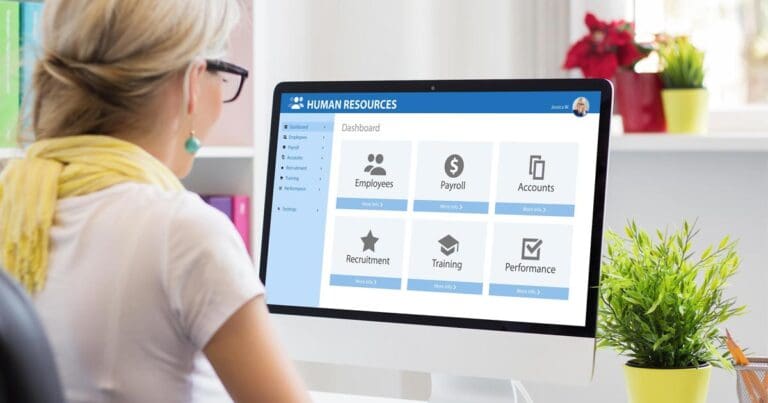Top Benefits of HR Automation Systems With Examples & Roles to Hire

With the new age of technology, HR automation systems have become an essential tool in optimizing companies’ HR departments.
Bringing with it a range of advantages and benefits, employers are now able to more efficiently manage their human resources tasks, ultimately streamlining their workflow and increasing productivity.
To help your HR department reach its full potential, take some time to learn what HR automation is and explore the top benefits, tools, and systems offered that can help you get the most out of your implementation.
What is HR Automation?
HR automation is the use of technology to automate and streamline certain HR tasks which would otherwise be completed manually by an employee. This includes everything from payroll, recruitment, onboarding processes, training management, and employee off-boarding.
Top 7 Benefits of HR Automation Systems
The top benefits of HR automation systems include time savings, increased security, improved transparency, less environmental impact, fewer mistakes, better resource allocation, and improved employee satisfaction.
1. HR automation systems save time
One of the biggest advantages of HR automation is that it can help streamline processes, saving you time and resources.
By automating mundane tasks such as data entry or filing paperwork, HR employees are better able to focus on higher-level responsibilities which require more attention and thought.
2. HR automation systems increase security
Implementing an HR automation system can also help increase security. By automating processes, employers have a better understanding of the data they have access to and who is able to view it.
This secure system can then be used to protect employee privacy while still ensuring accurate records and compliance with employment laws.
3. HR automation systems improve transparency
By providing employees with a central platform to access their data and manage tasks, everyone is on the same page when it comes to policies and procedures.
This improved transparency helps ensure that all employees are aware of any changes or updates in real time which could help prevent potential misunderstandings or conflict.
4. HR automation systems are environmentally conscious
Using an HR automation system also reduces paper usage, saving businesses money and helping the environment.
With fewer documents and forms to manage, employees are able to quickly access data in a secure manner without having to worry about printing out large amounts of paperwork.
5. HR automation systems lead to fewer mistakes
Manual mistakes in human resource departments can be costly and time-consuming. Automation helps to prevent data entry errors and other human errors which can cost companies more in the long run.
An HR automation system also allows for quicker cross-checking of data, so any issues with accuracy are quickly identified and corrected.
6. HR automation systems offer better resource allocation
With automated processes, it is easier to assign resources efficiently. This helps businesses make sure tasks are assigned properly and completed in a timely manner while helping to avoid over-allocating resources which can lead to waste.
Overall, an HR automation system can help ensure that the right people are working on the right tasks at any given time.
7. HR automation systems improve employee satisfaction
An HR automation system can also help improve employee satisfaction. By providing a streamlined experience and making it easier to access information, employees are able to quickly get the answers they need without having to wait in line or make multiple calls.
This improved experience can help foster better relationships between employers and employees, ultimately leading to higher employee morale.
Examples of automated HR processes
There are a number of examples of HR processes that can be automated that include onboarding & offboarding, time tracking & attendance management, and payroll & benefits management.
- Automated onboarding & offboarding
- Automated time tracking & attendance management
- Automated payroll & benefits management
- Automated recruitment & hiring processes
- Automated admin work
- Automated training management
- Automated communication
Automated onboarding & offboarding
Automating the onboarding and offboarding process can make it easier to ensure that all new hires are properly informed of company policies and procedures, while also helping with making sure employees who leave the company have their records updated quickly.
Automated time tracking & attendance management
Automation can be used to track employee hours and manage attendance, making sure everyone is being fairly compensated for their time while also ensuring that everyone is following the company’s policies regarding attendance.
Automated payroll & benefits management
HR automation systems can also be used to manage payroll and employee benefits, helping managers keep track of who is eligible for what type of benefit and when they need to be paid.
This also helps to ensure that all employees are receiving the benefits they are entitled to and that their information is kept up-to-date.
Automated recruitment & hiring processes
HR automation can also be used to streamline recruiting and hiring processes, helping employers quickly identify qualified candidates for open positions.
It can also help hiring managers keep track of what stage of the recruitment and hiring process different candidates are in to better manage the process.
Automated admin work
HR automation can also be used to automate admin tasks such as filing paperwork and data entry.
This helps HR professionals to streamline certain processes and free up time for them to focus on more important tasks.
Automated training management
By automating ongoing employee training and certification, employers are able to ensure that all employees have access to up-to-date training, receive automated reminders of training that is due, and track employee progress.
Automated communication
HR automation can also help streamline employee communication.
Automated emails and messages can be sent out to quickly alert employees of any changes in policy or procedure, or remind them of upcoming events and deadlines.
6 HR Automation Systems Roles to Hire
There are several HR Automation roles to hire to get the most out of these tools that include HR tech specialists, data analysts, change management specialists, project managers, IT specialists, and data privacy and compliance officers.
HR Technology Specialist
An HR technology specialist is responsible for setting up and maintaining HR automation systems.
They must have a deep understanding of the technology, as well as an understanding of how to apply it to HR processes.
HR Data Analyst
HR data analysts are responsible for analyzing the data gathered by HR automation systems.
They must be able to interpret the data and use it to make informed decisions about human resource management.
Change Management Specialist
A change management specialist is responsible for helping to transition employees from manual processes to automated ones by working cross-functionally with different departments.
They must have an understanding of how the system works and how it can be used to benefit the company.
Project Manager
A project manager is responsible for managing the implementation of HR automation systems.
They must have a clear understanding of the goals and objectives of the project, as well as an understanding of how to coordinate resources in order to ensure that it is completed on time and within budget.
IT Specialist
An IT specialist is responsible for ensuring that all software and hardware used in HR automation systems are correctly configured and working properly.
They must have a strong understanding of how the system works, as well as an understanding of network security protocols.
HR Data Privacy and Compliance Officer
An HR data privacy and compliance officer is responsible for ensuring that all data gathered by HR automation systems are compliant with any relevant laws or regulations.
They must also make sure that the data is kept safe and secure, as well as make sure that employees are aware of their rights when it comes to personal information.
Using HR Automation Systems
Implementing an HR automation system can help businesses make sure that they are operating efficiently and accurately.
By streamlining processes such as onboarding, payroll, and recruitment, employers can save time and money while also increasing employee satisfaction.
Additionally, it is also important to ensure that the right roles are filled in order to support these systems and ensure their success.
By hiring roles specifically for this purpose, businesses can ensure that their systems are running smoothly and providing real value.
Looking to hire top-tier Tech, Digital Marketing, or Creative Talent? We can help.
Every year, Mondo helps to fill over 2,000 open positions nationwide.
More articles about hiring and industry trends:
- Adobe XD May Be Discontinued: What This Means for Creatives & Employers
- The Impact of IoT: How Real-Time Monitoring is Transforming Industries
- How to Build Employee Engagement in a Remote Workforce
- Google Analytics 4: What Your Organization Needs To Prepare
- Big Tech Job Cuts Don’t Mean Demand for Tech Professionals Is Over
- The World of Robotics: Industries Leveraging Robotics Engineers
- Salesforce Admin Jobs to Hire to Get the Most Out of Your Investment
- Benefits of Digital Transformation in Healthcare with Examples
- HR Technology in Hiring: Streamlining Your Recruitment & Onboarding



